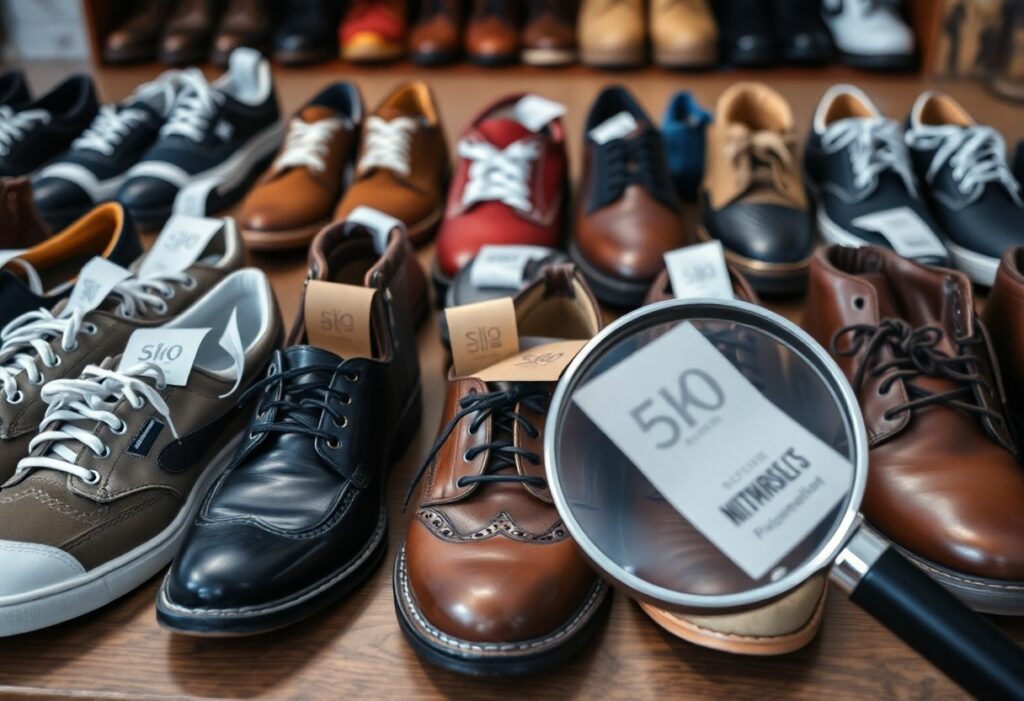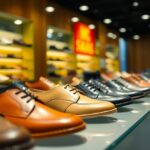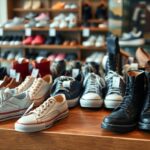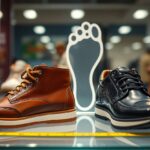
Shoes shopping in the second-hand market can save you up to 70% on premium footwear. You can make smart purchases by learning how to evaluate used shoes properly. Your success in finding quality second-hand shoes depends on understanding key inspection points and knowing reliable sources. Be careful of heavily worn shoes that may cause foot problems due to previous owner’s wear patterns. By following this guide, you will learn how to spot authentic designer shoes in excellent condition and avoid common buying mistakes. These tips will help you build a quality shoe collection while staying within your budget.

Understanding Second-Hand Shoe Types
The second-hand shoe market offers a range of quality footwear from vintage classics to barely-worn designer pieces. After understanding the different categories, you can make better purchasing decisions.
| Casual Shoes | Sneakers, loafers, boat shoes |
| Formal Shoes | Oxford, derby, brogues |
| Athletic Shoes | Running, training, sports-specific |
| Designer Shoes | Luxury brands, limited editions |
| Vintage Shoes | Classic styles, rare finds |
Casual and Formal Styles
For your everyday needs, second-hand casual shoes offer comfort and style at reduced prices. You can find everything from barely-worn loafers to vintage dress shoes, with prices typically 40-60% lower than retail.
Construction Methods and Materials
Even the finest shoes can show wear patterns, so you need to check the sole construction, stitching quality, and material integrity. You should focus on shoes with Goodyear welted construction, as these can be resoled multiple times.
Another important aspect is examining the leather quality and interior lining. You should look for shoes with minimal wear on the insole and heel counter, as these areas directly affect comfort and fit. Full-grain leather shoes typically age better and offer more value in the second-hand market.
Essential Factors to Consider
One of the most important steps in buying second-hand shoes is evaluating key aspects like material quality, construction method, and overall condition. Your checklist should include:
- Original price and brand reputation
- Construction type (Goodyear welted preferred)
- Material authenticity
- Size accuracy
After checking these factors, you can make an informed decision about the shoe’s value.
Wear Assessment and Condition
Wear patterns tell you important stories about second-hand shoes. You should examine sole wear patterns, creasing on uppers, and heel degradation. Look for signs of proper care like polish marks and clean welts. Check the insole for excessive molding to previous owner’s foot shape. A well-maintained pair will show even wear across both shoes.
Pricing and Value Evaluation
Now is the time to compare prices across different platforms. You can expect to pay 30-60% less than retail for lightly used premium shoes. Your budget should account for potential restoration costs. Check recent sales of similar items to gauge market value.
Factors affecting the price include the brand’s prestige, original retail price, shoe age, and current condition. You should consider:
- Current retail price of new models
- Cost of any needed repairs
- Rarity of the style or color
- Authentication proof available
Step-by-Step Buying Process
If you want to buy second-hand shoes safely, follow this proven process to get the best value for your money. The process helps you avoid common pitfalls and ensures you make informed decisions.
| 1. Research the brand and model | 2. Check seller ratings |
| 3. Request detailed photos | 4. Verify sizing information |
| 5. Inspect wear patterns | 6. Verify return policy |
Measurements and Sizing
Measurements are important for a good fit in second-hand shoes. You should know your foot length, width, and arch length. Compare these with the seller’s measurements of insole length and width. Allow for a 0.5-inch toe space in dress shoes.
Authentication Methods
If you’re buying premium brands, authentication protects you from counterfeits. Check for brand-specific markings, serial numbers, and quality of stitching. Compare the shoes with official product photos from the manufacturer.
StepbyStep authentication involves examining the logo placement, material quality, and construction details. Request close-up photos of the insole stamp, outsole, and any brand markings. Avoid listings with blurry or limited photos.

Where to Find Quality Second-Hand Shoes
Keep your search focused on reliable sources to find the best second-hand shoes. You can explore thrift stores, online marketplaces, and specialty resale shops. Each source offers different advantages, from competitive pricing to authenticated products. Your local options might include consignment stores and vintage boutiques, while online platforms give you access to a global marketplace.
Online Marketplaces and Platforms
One of your best options for finding second-hand shoes is through online platforms like eBay, Poshmark, and Depop. These sites offer buyer protection and often feature detailed product descriptions. You can find up to 70% off retail prices on premium brands. Make sure you check seller ratings and ask for additional photos if needed.
Specialty Resale Stores
Where you shop matters significantly when looking for quality second-hand shoes. Specialty resale stores offer pre-verified authentic items and often provide return policies. You can find these stores in major cities, with many now offering online shopping options.
A major advantage of specialty resale stores is their expert authentication process. Your purchases come with guarantees of authenticity, and the staff can help you find the right fit. These stores typically clean and condition all shoes before selling, ensuring you receive items in ready-to-wear condition.
Tips for Smart Shopping
For finding the best second-hand shoes, you need to check the wear patterns, sole condition, and leather quality. You should examine shoes in daylight, test their flexibility, and verify size accuracy. Perceiving signs of excessive wear or damage can help you avoid costly mistakes.
Negotiation Strategies
With price comparison data from multiple sources, you can make informed offers. You should point out minor flaws politely, bundle multiple pairs for better deals, and be ready to walk away. Your research on retail prices gives you solid ground for negotiations.
Seasonal Buying Guidelines
Tips for seasonal shopping include buying winter boots in summer when prices drop by 40-60%. You should target dress shoes during post-holiday sales and look for summer styles in winter clearances.
Seasonal shopping patterns show that January and July offer the best deals on high-end shoes. You can find premium brands at 30-50% below regular second-hand prices during these periods. Your timing of purchases around major clearance events can result in significant savings.

Pros and Cons of Buying Used Shoes
Many shoe buyers find second-hand purchases to be a smart choice for their wardrobe. Your decision to buy used shoes can lead to significant savings of up to 70% off retail prices, but requires careful consideration of several factors.
1. Lower prices | Risk of hidden damage 2. Access to rare models | Possible hygiene issues 3. Reduced environmental impact | Pre-shaped to another foot 4. Premium brands affordable | Limited return options 5. Instant wear-in | Potential wear and tear 6. Vintage styles available | Size uncertainty 7. Quality materials | Previous owner’s care habits 8. Cost-effective | Authenticity concerns
Advantages and Cost Benefits
Cost savings are your primary benefit when buying second-hand shoes. You can find high-end brands at 30-70% below retail prices, making premium footwear more accessible. Your budget stretches further, allowing you to build a quality shoe collection faster.
Potential Risks and Drawbacks
The main concerns with used shoes include hygiene issues and structural damage. Your purchase may have hidden problems like worn insoles or damaged support structures that aren’t visible in photos or initial inspection.
This risk increases with heavily worn shoes. You should check for signs of excessive wear, examine the sole condition, and verify the shoe’s authenticity before purchase. Your careful inspection can help avoid costly mistakes and ensure a safe, satisfying purchase.
To wrap up
On the whole, your success in buying second-hand shoes depends on your attention to key details and smart shopping choices. You can find excellent deals by checking the shoe’s wear level, examining sole conditions, and buying from reliable sources like specialized stores or trusted online marketplaces. Your focus should be on shoes with minimal wear that haven’t fully conformed to another person’s foot shape. If you keep these tips in mind and stay ready to resell if needed, you’ll increase your chances of finding high-quality second-hand shoes that fit well and offer great value for your money.
FAQ
How can I check the condition of second-hand shoes before buying?
Check the soles first – they show the true wear level. Look at heel tips and toe areas for wear patterns. Examine the leather upper for deep creases or damage. Check inside the shoes for molded footprints or worn insoles. Good condition shoes should have minimal wear marks, intact stitching, and no separation between sole and upper.
What are the best places to find quality second-hand shoes?
You can find good deals on specialized websites like Abbot’s Shoes and Leffot’s pre-owned section. Online marketplaces include eBay, Styleforum Buy & Sell, and The Shoe Snob marketplace. These platforms offer verified sellers, clear photos, and buyer protection. Local thrift stores can also yield finds, but selection varies greatly.
What size considerations should I keep in mind when buying used shoes?
Buy shoes close to your regular size, as used shoes have already shaped to the previous owner’s feet. Check if the seller provides the exact measurements of insole length and width. Look for shoes with minimal wear, as heavily used pairs may have stretched or molded to a different foot shape. Be ready to resell if the fit isn’t right, even if the deal seems good.








I really appreciate how you broke down the different types of second-hand shoes. It’s so easy to get overwhelmed by the sheer variety out there, especially when it comes to distinguishing between vintage finds and barely-worn designer pieces. I remember when I first ventured into the second-hand market, I was mainly focused on price but soon realized that understanding the different shoe types made a huge difference in my purchases.
I’ve always found the second-hand market to be a treasure trove for shoe enthusiasts. It’s true; you can discover some amazing finds, particularly if you take the time to research the type of shoes that suit your needs and style. I have a pair of vintage loafers that I got at a thrift store, and they not only look great but also have a story behind them.
It’s great to hear about your experience with the second-hand market. Vintage loafers can have such character, and the stories they carry always add a special touch. It’s interesting how shoes can tell a story not just about their design but also about the times they’ve been through.
I completely agree with you about the character of vintage loafers. There’s something about the patina on aged leather or the uniqueness of the stitching that modern shoes just can’t replicate. I often find myself imagining the stories behind each pair I come across, thinking about who wore them, where they might have traveled, and the moments they witnessed.
I really appreciate the insights on second-hand shoe shopping! I’ve recently started exploring thrift stores and online marketplaces, and it’s amazing how much you can save while scoring unique finds. I’ve learned a lot about the importance of inspecting shoes thoroughly, particularly for wear patterns that could affect comfort.
It’s great to hear that you’re diving into the world of second-hand shoe shopping. There’s something special about finding a pair that’s not just a good deal but also has a story behind it. Thrift stores and online marketplaces can really open up a treasure trove of options that aren’t available in typical retail settings.
It’s fascinating to see the value in second-hand shopping, especially when it comes to footwear. I’ve found that not only do you save significantly, but there’s also something uniquely rewarding about breathing new life into a previously cherished item.
I really appreciate the insights you’ve shared about second-hand shoe shopping. It’s amazing how much value you can find in the second-hand market, especially for those of us who love premium footwear but don’t want to break the bank. I’ve dabbled in second-hand shopping for a while now, and I can attest to the thrill of discovering a nearly-new pair of designer shoes that someone else didn’t appreciate as much as I do.
I really appreciate your insights on second-hand shoe shopping! It’s fascinating how much we can save while still treating ourselves to premium footwear. I’ve dabbled in thrifting for shoes myself and learned the hard way about inspection points—especially when I picked up a pair that looked stylish but turned out to have significant wear. Your tips about avoiding heavily worn shoes to prevent foot issues resonate with me.
I really appreciate how you broke down the types of second-hand shoes; it definitely gives a clearer picture of what to look for. I’ve started dabbling in second-hand shopping recently and have found some gems, but it can be overwhelming trying to spot quality pieces. I’ve mainly focused on casual sneakers, but your reminder about heavily worn shoes makes me think twice.
I really appreciate this guide on navigating the second-hand shoe market—it’s so true that finding quality footwear at a fraction of the retail price is incredibly satisfying. I’ve recently started exploring thrift stores and online platforms for shoes, and it’s been eye-opening how much variety is available.
I’ve always been a bit skeptical about thrifting shoes, but this guide makes it sound way more approachable! I love the idea of scoring designer pieces without breaking the bank. Just recently, I found a barely-worn pair of leather brogues at a local thrift store. They were a bit scuffed up, but after some polishing, they looked brand new! It’s incredible how second-hand shopping can also be a fun treasure hunt.